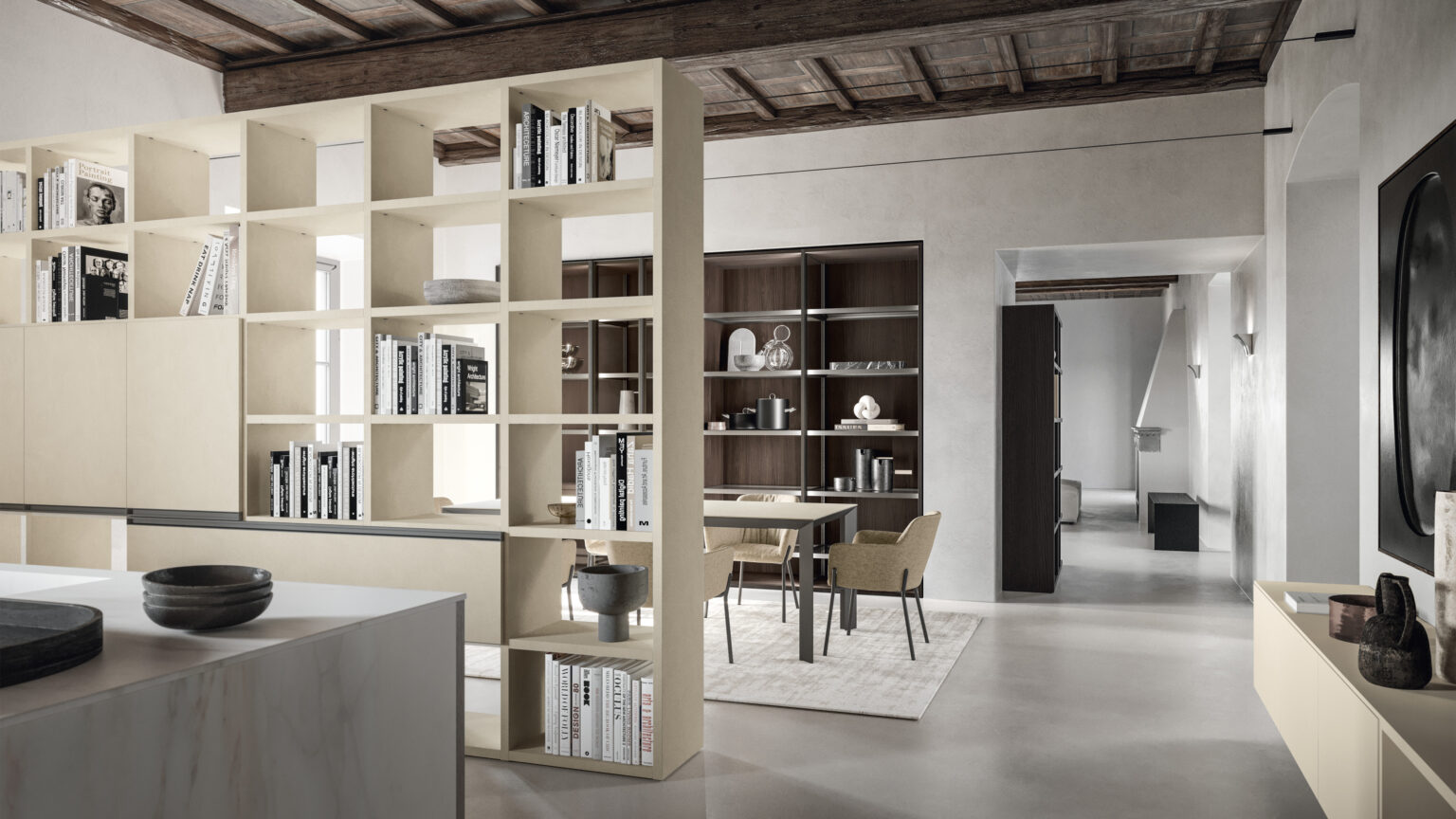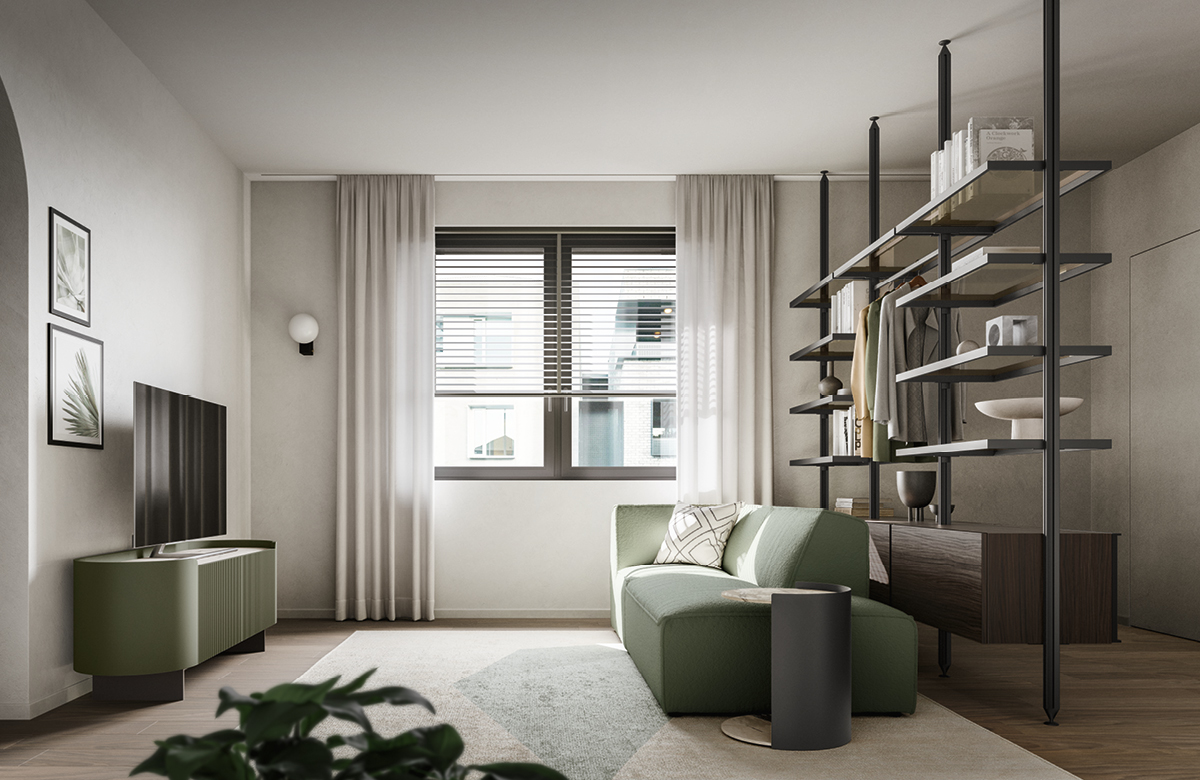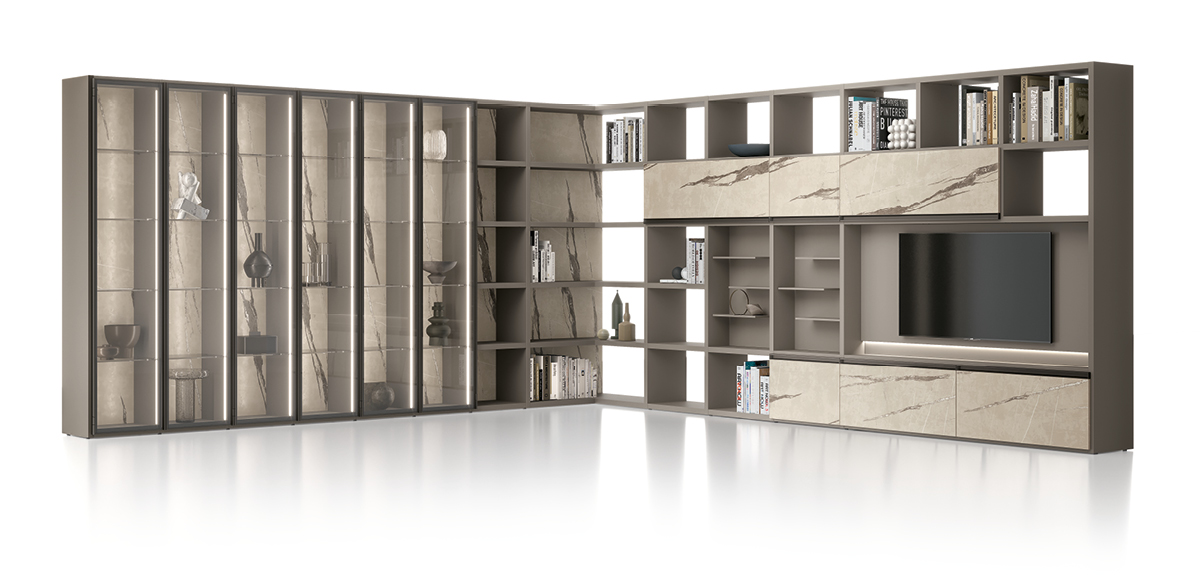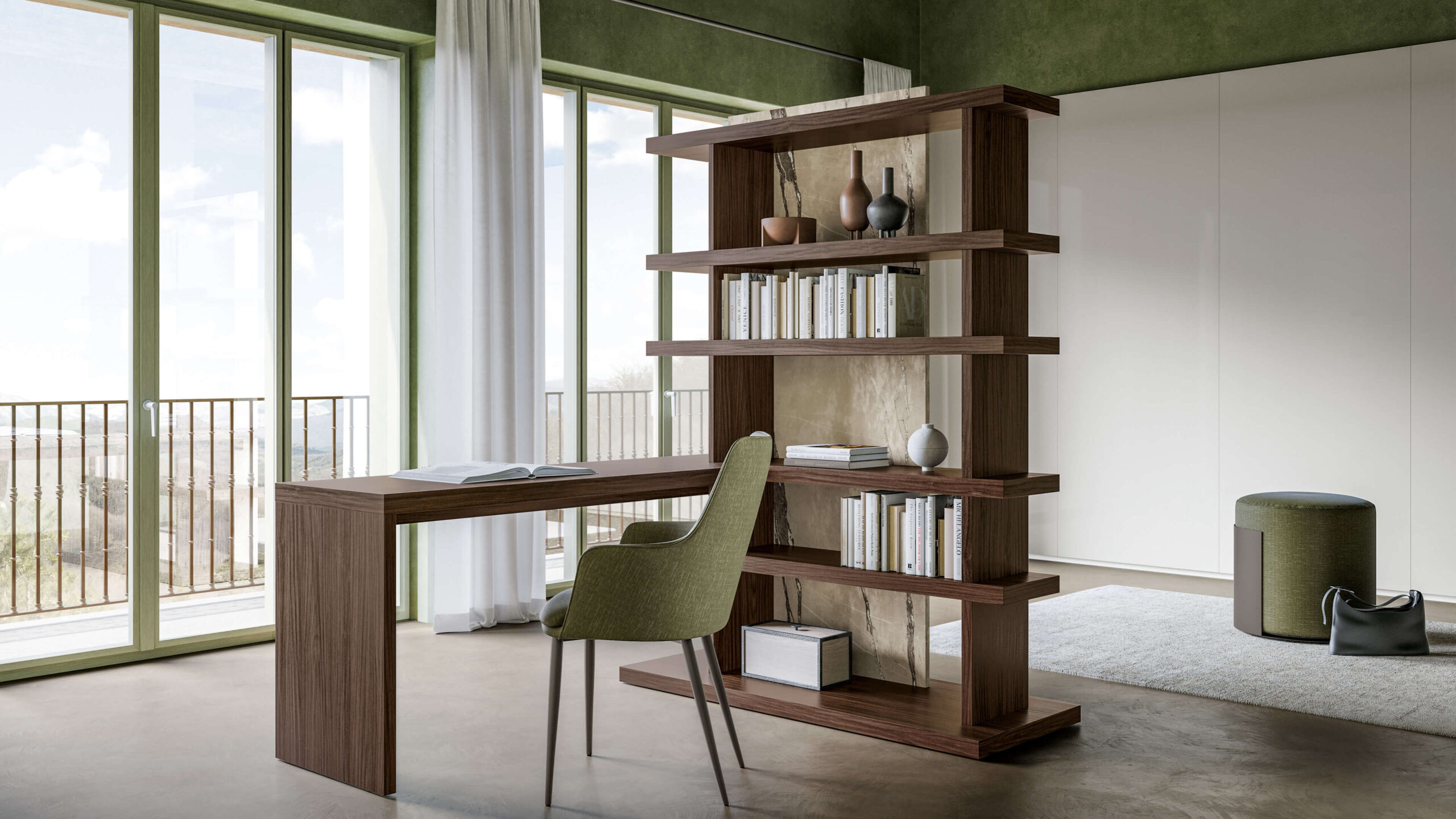Partition bookcases for stylish division of spaces
The search for functional and customised solutions, adapted to the specific dimensions of a space and individual tastes, has become a priority for contemporary furniture. In this context, partition bookcases are central in a stylistic evolution aimed at optimising domestic space without neglecting design and aesthetics.
But what exactly is a partition bookcase?

The terms “partition bookcase” and “room-divider bookcase” refer to a reimagining of the traditional bookcase that goes beyond its primary storage function, creating partitions that separate spaces without closing them off. Unlike fixed partitions, room-divider bookcases offer a dynamic solution, dividing space without compromising the open-plan feel and allowing those in the different spaces to look through their open compartments. This solution combines practicality and elegance, as the great versatility of the bookcase can give it a central role in the definition of contemporary living spaces.
In this article, we will discover several partition-bookcase solutions and styles from Santalucia Mobili, with a focus on materials and finishes that maximise the opportunity for customisation. We will also explore how to fit bookcases into various rooms, from attics to open spaces, and how to make them decorative, offering inspiration for unique customisation of your home.
History and development of partition bookcases
The history of partition bookcases is intrinsically tied to the evolution of interior design and the conceptual declination of living spaces. Bookcases were originally considered simply as a storage solution. Over time, their role has changed and they have become important, sculptural interior pieces in their own right.
Elements such as screens and curtains were the first solutions used to divide spaces. The concept of the partition bookcase in the modern sense began to take shape during the Renaissance, when the libraries of noble families became increasingly imposing and in need of specially designed solutions. Initially, bookcases were conceived as open structures, with exposed shelves that enabled easy access to the volumes stored on them.
Partition bookcases evolved with changing interior requirements: in the 18th century, closed bookcases with doors became popular, hiding books and protecting them from dust. In England, designers such as Thomas Chippendale helped establish an elegant and functional style.
In the Victorian period, bookcases appeared with increasingly elaborate forms, often incorporated into other furniture such as desks and sideboards, thanks to the influence of artists including Gustave Herter and Charles Eastlake.
In the late 19th and early 20th century, the world of design took an important turn with the rise of revolutionary currents such as Arts and Crafts and, later, Bauhaus movements. These introduced a new approach to bookcase design, moving beyond the functional purpose, and considering the bookcase as a decorative object its own right. During this period, designers Charles Rennie Mackintosh and Walter Gropius led the way, integrating clean, functional lines with a strong sense of aesthetics in their creations. These were bookcases as artistic expression, harmoniously combining form and function.
With the arrival of 20th-century Modernism, and protagonists such as Le Corbusier and Ludwig Mies van der Rohe, the concept of functional, minimalist furniture found full expression. Partition bookcases played a key role in living spaces, with clean designs and innovative materials. This phase marked a further step in the transformation of bookcases from static pieces of furniture to dynamic, integral components of modern spaces.
In the post-war period, which was characterised by an increase in small homes and a need to optimise space, bookcases became functional dividing elements. These solutions not only separate rooms efficiently, but also allow light to pass through and avoid closing off spaces from view.
During the 1950s and 1960s, Scandinavian design was responsible for another significant phase in the history of partition bookcases. Leading figures such as Alvar Aalto and Arne Jacobsen helped redefine these elements with clean lines and natural materials, further emphasising the importance of combining functionality and aesthetics.
The 1980s and 1990s brought Post-Modernism, with stylistic experiments that contributed to original and expressive furniture, such as the iconic Carlton freestanding bookcase by Ettore Sottsass, designed in 1981.
In the late 20th and early 21st century, the focus shifted towards customisation and versatility: partition bookcases were modular and adapted to any space and interior style.
It can be said that modern design ranges from minimalist bookcases to art in the truest sense, embracing the plurality of styles and requirements of the 21st century. Patricia Urquiola and Piero Lissoni, for example, create partition bookcases that are true artworks, often using innovative designs and experimental materials.
The history of partition bookcases is a fascinating journey through design, demonstrating how a piece of furniture can evolve to meet the changing needs of different eras and plural aesthetic sensibilities of designers in each period. Today, these bookcases are considered key elements in interior design as they enable unique combinations of form and function.
Functional and aesthetic benefits of partition bookcases
Partition bookcases have a dual purpose: firstly, they separate two rooms without creating a complete partition like a traditional wall and maintaining a sense of visual continuity. Secondly, the combination of open and closed spaces serves to effectively organise, contain and decorate rooms. This functional aspect is particularly evident in the solution featured in the photo, where the bookcase separates kitchen and dining room. This solution is ideal to partition spaces without resorting to masonry work and becomes almost essential in rooms with beamed ceilings, for example.

In terms of aesthetics, partition bookcases, compared to a traditional wall, are lighter visually and help to maintain a feeling of open space and brightness within the room.
Partition bookcase styles and materials
The choice of colours and materials is crucial in defining the style of the bookcase and, more generally, the room in which it is placed. Natural wood, lacquered colours, marble effects, textured finishes, metal and glass enable complete customisation based on individual taste and context.
The contemporary partition bookcase
Partition bookcases with a modern style use clean lines, geometric shapes and on-trend pairings. Modularity is often a distinguishing feature, allowing for tailor-made configurations that are perfectly suited to the available space.

In the photos, the double-sided partition bookcase from the Homy Giorno collection with coloured doors is distinguished by an interplay of solid volumes and empty space that makes it visually dynamic from both sides.

The Nordic partition bookcase
Nordic style is reflected in partition bookcases through the use of natural wood, light colours and linear, essential designs. The photo shows the freestanding Bend bookcase with its wooden shelves and white lacquered dividers that fully embody this aesthetic. The choice of natural wood gives the room warmth and authenticity, while the light shades help to generate a sense of brightness and space.

The industrial partition bookcase
Industrial partition bookcases feature a shelving-inspired design, using robust materials like metal to create an urban atmosphere. In fact, the name of the bookcase in the photo is “Urban”. It is positioned between the entrance and living room and consists of metal uprights, fixed to the floor and ceiling, supporting storage modules, glass shelves and a clothes-rail accessory.

How to integrate room-divider bookcases into your space
Integration of partition bookcases into a room requires careful consideration of its square footage and architectural characteristics. Santalucia Mobili’s customised solutions make it possible to design bookcases that fit perfectly into any space, large or small, linear or irregular.
The corner bookcase, for example, combines a double-sided section open to another room with a section that sits against the wall. This solution is ideal for large, open-plan spaces that need a well-defined partition and can accommodate large pieces of furniture.

The two-corner double-sided bookcase encloses a space and seems to almost create a room within a room.

The versatility of the double-sided bookcase can be further expanded with bridging solutions, left free to create a passageway or equipped with other elements, e.g. a TV stand, as featured in the photo.

One interesting space-saving solution is the partition bookcase integrated into the Evan sofa. This is available in various lengths and the height can be increased as desired. This solution is especially successful if the sofa is placed in the middle of the room or along a passage way.

For small spaces that are difficult to furnish, such as attics, a bookcase with uprights is the ideal choice to optimise space while keeping things light.

Decorating and customising these elements adds an extra layer of style to this functional solution. Bookcases can contain books, of course, but also artistic objects and decorative accessories. Partition bookcases are usually double-sided so, from a decorative point of view, it is always a good idea not to overload them and to leave empty spaces free to let the light through.
Inspiration and ideas for partition bookcases
The versatility and variety of styles and materials of Santalucia Mobili partition bookcases give people the opportunity to redefine and enhance their home environment.
In addition to the options explored in the previous paragraphs, there are multifunctional solutions, such as those designed to create a study or work area within a room by combining the partition bookcase with a desk.

Low, double-sided bookcases can be paired with sofas and storage modules, creating new corner features that transform spaces and establish a more dynamic and functional living area.

Furthermore, room-divider bookcases can take on the appearance of a traditional partition wall, enabling creation of entrance areas, as shown in the photo, even in spaces originally conceived as a single room.

Basically, exploring the world of partition bookcases means opening the door to a new way of utilising and living in a space, giving your home a distinctive and functional touch.
Browse the Homy Giorno Spalle and Homy Giorno Details catalogues to find further inspiration and interiors that express your personality.